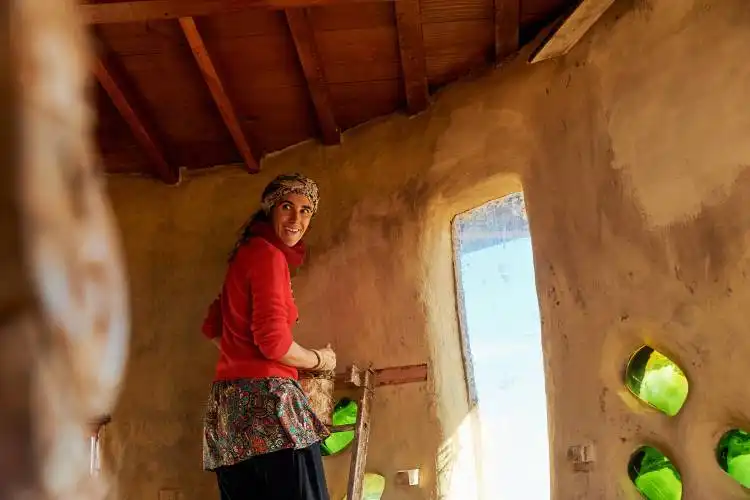Start a Bamboo Farm
Unleashing Your Inner Panda: The Exciting Opportunities in Bamboo Farming
| Updated


BAMBOO FARM
Venture in the fascinating world of bamboo farming, where your cash crop regenerates 20 times faster than trees. With the shifting global focus towards sustainable practices and materials, bamboo, used in furniture, construction, papermaking, and even clothing, is rightly Ping-Ponging into limelight. By dipping your toes in this business, you will be cultivating these rapid-growing grasses for various uses. So, channel your inner panda and let the bamboo business bloom!
Jump to Business Plan
RELATED BUSINESS IDEAS
Browse ALL Sustainability & Eco-Friendly Initiatives Business Ideas
Discover Your Perfect Domain
Unlock the door to your online success with our hand-picked selection of premium domain names. Whether you're starting a new venture or rebranding an existing one, the right domain can set the tone for your digital presence. Browse through our curated list, each with its unique potential to enhance your brand's visibility and credibility.
BAMBOO FARM MINI BUSINESS PLAN
This a quick reality check to help you identify the strengths and weaknesses of your business concept before you dive in.
Expected Percent Margin:
- Gross Margin: 45-55%
- Net Profit Margin: 10-20%
Earnings Expectations:
- Daily Earnings: $150 - $250
- Weekly Earnings: $1,050 - $1,750
- Monthly Earnings: $4,500 - $7,500
- Annual Earnings: $54,000 - $90,000
Actions to Hit Those Numbers:
Planting and Cultivation:
- Initial Investment: At least $10,000 - $20,000 for quality bamboo seeds/plants and land preparation.
- Irrigation: Regular watering, especially in the initial stages of growth, is crucial. Consider the installation of an irrigation system.
Marketing and Customer Acquisition:
- Website: Develop an informative website with online order facility.
- Networking: Join local and regional agriculture business networks.
Sales and Customer Experience:
- Value Addition: Consider offering value-added bamboo products.
- Quality Assurance: Monitor health and quality of the bamboo frequently.
Harvesting and Supply:
- Harvesting Method: Learn and apply optimal bamboo harvesting methods to maximize productivity.
- Reliable Supply Chains: Establish reliable supply chains for prompt delivery.
Cost Control:
- Pest Control: Invest in ecological pest control methods to limit damage.
- Maintenance: Regular property maintenance is necessary.
Business Operations:
- Farm Size: Larger scale bamboo farms tend to be more profitable because of economies of scale.
- Customer Volume: Target a variety of customer categories such as landscapers, garden centers, crafts manufacturers, and bamboo product manufacturers.
These figures are generalized estimations and can vary greatly depending on location, type of bamboo, economic conditions and individual business strategies. Always consult with a financial advisor for additional guidance and personalized advice.
NOT WHAT YOU HAD IN MIND? Here are more ideas



Browse ALL Sustainability & Eco-Friendly Initiatives Business Ideas
Grab Your Business Website Name
Before you get caught up in the whirlwind of setting up your business, invest in a domain name. It's a small but significant step that lays the foundation for your brand and makes it easier for customers to find and trust you. Just like you wouldn't build a house without securing the land first, don't build a business without securing your domain name.
"Why? Can't that wait?" Here's why it shouldn't
Step 1: Determine if Starting a Bamboo Farm is the Right Endeavor
Breakdown of Startup Expenses
Before starting a bamboo farm, it is important to understand the startup expenses associated with the business. This includes the cost of land, the cost of bamboo plants, the cost of irrigation and other necessary equipment, and the cost of labor. Depending on the size of the farm, these expenses can range from a few hundred dollars to tens of thousands of dollars. It is important to research the costs associated with starting a bamboo farm in order to determine if it is the right endeavor.
Breakdown of Ongoing Expenses
In addition to the startup expenses, it is important to understand the ongoing expenses associated with running a bamboo farm. This includes the cost of labor, the cost of fertilizer, the cost of water, the cost of pest control, and the cost of harvesting and processing the bamboo. These expenses can add up quickly, so it is important to understand the costs associated with running a bamboo farm before starting the business.
Examples of Ways to Make Money
Once the startup and ongoing expenses are understood, it is important to understand the ways to make money from a bamboo farm. This includes selling the bamboo directly to customers, selling bamboo products such as furniture or flooring, and selling bamboo shoots. Additionally, bamboo can be used to produce biofuel, which can be sold for a profit. Understanding the different ways to make money from a bamboo farm can help determine if it is the right endeavor.
Step 2: Name the Business
When it comes to naming a business, it is important to choose a name that is memorable and easy to pronounce. It should also be unique and reflect the values of the business. Additionally, it should be easy to search for online and be available as a domain name.
When brainstorming potential names, it is important to consider the type of business and the target audience. For example, a bamboo farm may want to include the word “bamboo” in the name to make it more recognizable. It may also be beneficial to include words that evoke a feeling of sustainability or eco-friendliness.
When the list of potential names has been narrowed down, it is important to check the availability of the domain name. This can be done by searching online to see if the domain name is available. It is also important to check the availability of the trademark. This can be done by searching the United States Patent and Trademark Office (USPTO) database.
Finally, it is important to consider the cost of the domain name and trademark registration. Domain names typically cost between $10 and $15 per year, while trademark registration can cost anywhere from $225 to $400. It is important to factor these costs into the overall budget for the business.
Step 3: Acquire Land
When acquiring land for a bamboo farm, there are a few considerations to keep in mind. First, the land should be large enough to accommodate the desired number of bamboo plants. The soil should also be of good quality and should be able to support the growth of bamboo. Additionally, the land should have access to water and sunlight, as these are essential for the growth of bamboo. Furthermore, the land should be located in an area that is not prone to flooding, as this can damage the bamboo plants. Finally, the land should be close to a market where the bamboo can be sold.
Finding Land
When looking for land to start a bamboo farm, it is important to research the local area and identify potential locations. Local government offices, such as the county clerk’s office, can provide information on available land. Additionally, local real estate agents may be able to provide information on land for sale. Additionally, online resources such as Craigslist and Zillow can also be used to find land for sale. Finally, it is important to visit the land in person to ensure that it meets the criteria for a successful bamboo farm.
Step 4: Prepare the Land
Preparing the Soil
Before planting the bamboo, the soil must be prepared. This includes testing the soil for pH levels, nutrient levels, and other factors. If the soil is not suitable for bamboo, it may need to be amended with compost, fertilizer, or other soil amendments. Additionally, the soil should be tilled to ensure that the bamboo roots can spread and take hold. If the soil is too rocky or sandy, it may need to be amended with organic matter to help the bamboo take root.
Planting the Bamboo
Once the soil is prepared, the bamboo can be planted. Bamboo is a fast-growing plant, so it is important to plant the bamboo in a way that will allow it to spread and take hold. This can be done by planting the bamboo in a grid pattern, or by planting multiple plants in a single hole. Additionally, it is important to water the bamboo regularly to ensure that it takes root and grows properly. If the bamboo is planted in a pot, it should be watered every day. If it is planted in the ground, it should be watered at least once a week.
Step 5: Care for the Bamboo
Watering
Watering is essential for the health and growth of bamboo. It should be done regularly, as bamboo needs a consistent supply of moisture. Depending on the climate and the type of bamboo, the amount of water needed can vary. In general, bamboo should be watered at least once a week, and more often in hotter climates. If the soil is dry, water should be applied more frequently. It is important to avoid overwatering, as this can lead to root rot and other problems.
Fertilizing
Fertilizing is also important for the health and growth of bamboo. Bamboo needs a balanced supply of nutrients to thrive. Fertilizers should be applied every few months, depending on the type of bamboo and the climate. It is important to use a fertilizer that is specifically designed for bamboo, as other types of fertilizer can be too strong and can damage the roots.
Pruning
Pruning is an important part of caring for bamboo. It helps to keep the plants healthy and encourages new growth. Pruning should be done regularly, as it helps to keep the plants from becoming too large and unruly. Pruning should be done carefully, as it can be easy to damage the plants. It is important to use sharp pruning shears and to make sure that the cuts are clean and even.
Step 6: Harvest the Bamboo
When to Harvest
The timing of the harvest is important for the success of the bamboo farm. Bamboo should be harvested when it has reached its maximum height and diameter, which is usually between 3-4 years after planting. The best time to harvest is during the dry season when the bamboo is at its strongest.
How to Harvest
The harvesting process is relatively straightforward. First, the bamboo should be cut at the base of the culm, just above the soil line. Then, the culm should be cut into sections of desired length. Finally, the sections should be bundled and transported to the desired destination. It is important to note that the harvesting process should be done carefully so as not to damage the culms. Additionally, the harvested bamboo should be dried and stored in a cool, dry place to ensure its longevity.
Step 7: Market the Bamboo
Identifying Potential Customers - Identifying potential customers is essential to the success of any business. When it comes to selling bamboo, potential customers can include landscapers, gardeners, nurseries, and other businesses that use bamboo for decorative purposes. It is important to research the local market and identify potential customers who may be interested in buying bamboo from your farm. Additionally, it is important to consider the type of bamboo that you are growing and the potential market for that type of bamboo.
Pricing the Bamboo - Once you have identified potential customers, it is important to set a competitive price for the bamboo. It is important to research the market and find out what other bamboo growers are charging for their bamboo. Additionally, it is important to consider the cost of production and the cost of labor when setting the price. It is also important to consider the quality of the bamboo and the potential profit margin. Finally, it is important to consider the potential demand for the bamboo and the potential competition in the market.
Step 8: Manage Finances
Record Keeping
Keeping accurate records of all financial transactions is essential for any business. This includes tracking income, expenses, and investments. It is important to keep track of all financial records in order to be able to accurately report profits and losses to the IRS. Additionally, keeping accurate records can help you make informed decisions about the future of your business. It is important to keep track of all receipts, invoices, and other documents related to the business. This will help you stay organized and ensure that you are able to access the information you need when you need it.
Tax Considerations
When starting a bamboo farm, it is important to understand the tax implications of the business. Depending on the size and scope of the business, you may be required to pay taxes on the profits you make. Additionally, you may be eligible for certain tax deductions or credits that can help you save money. It is important to consult with a tax professional to ensure that you are in compliance with all applicable laws and regulations. Additionally, it is important to keep accurate records of all financial transactions in order to be able to accurately report profits and losses to the IRS.
Step 9: Expand the Business
Adding New Varieties of Bamboo
Once the business is up and running, it is important to consider adding new varieties of bamboo to the farm. This can help to increase the variety of products that can be offered to customers. It is important to research the different types of bamboo that are available and determine which ones are best suited for the climate and soil conditions of the area. Additionally, it is important to consider the cost of purchasing the new varieties, as well as the cost of maintaining them. It is also important to consider the labor involved in planting and harvesting the new varieties.
Adding New Customers
Once the business is established, it is important to consider ways to attract new customers. This can include advertising, creating a website, and attending local events. Additionally, it is important to consider the cost of these marketing efforts, as well as the potential return on investment. It is also important to consider the cost of providing customer service, as well as the cost of shipping and handling products. Additionally, it is important to consider the cost of providing discounts or other incentives to attract new customers. Finally, it is important to consider ways to build relationships with existing customers, such as offering loyalty programs or other incentives.
EXPLORE MORE CATEGORIES
Browse ALL Business Idea Categories
TAKE THE NEXT STEPS









